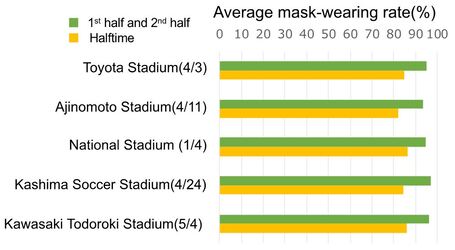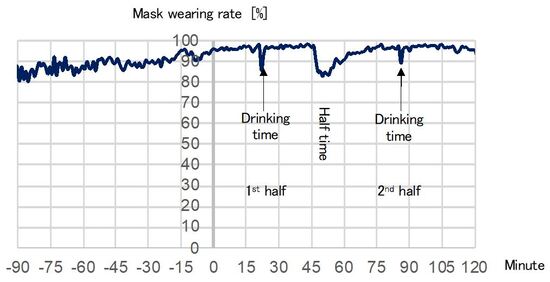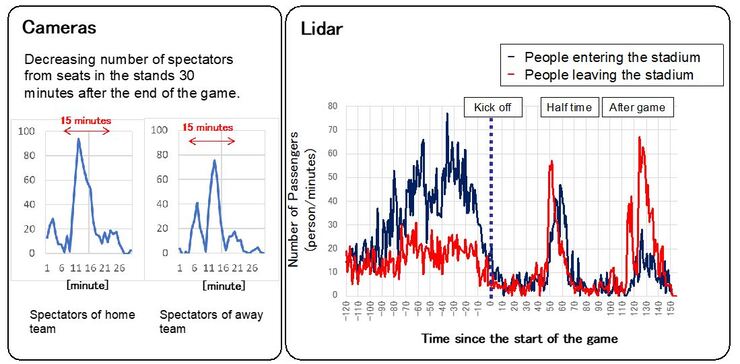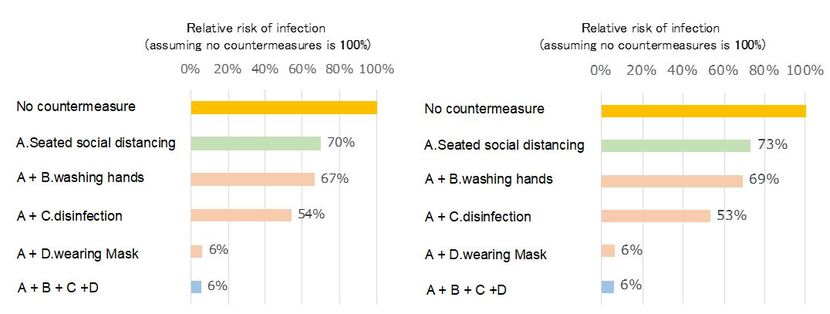Update(MM/DD/YYYY):06/18/2021
Investigation into preventing COVID-19 infections at J.League stadiums and clubhouses (third report)
-Evaluating the effectiveness of infection risk reduction measures and mask wearing rates in stadiums-
Researchers) YASUTAKA Tetsuo, ONISHI Masaki, BANDO Yoshiaki, NAITO Wataru, IWASAKI Yuichi, SHINOHARA Naohide
Key points
- Evaluated percentage of spectators wearing masks at five different stadiums using AI-based image analysis
- Found average of 92.5 % of spectators to be wearing masks during matches
- Assessed the effectiveness of infection prevention measures in the stadiums using parameters obtained from the investigation
- Estimated reduction in risk of infection of 94 % is possible by practicing social distancing when seated, wearing masks, using disinfectant, and washing hands when compared to not taking these measures.
Overview
The National Institute of Advanced Industrial Science and Technology (AIST) has made further progress in an investigation assessing the risk of COVID-19 infections spreading among spectators during Japan Professional Football League (J. League) matches and evaluating the effectiveness of various prevention measures. Carbon dioxide (CO2) sensor was used to evaluate ventilation (poor airflow) and cameras and image analysis were used to evaluate the percentage of spectators wearing masks. In addition, crowd congestion levels, the degree of close contact between spectators, and spectator behavior were analyzed using lidar and acoustic sensors. Led by President ISHIMURA Kazuhiko, AIST's team consisted of the Research Institute for Geo-Resources and Environment (director: IMAIZUMI Hiroyuki), the Resource Geochemistry Research Group (Research group director: YASUTAKA Tetsuo), the Artificial Intelligence Research Center (director: TSUJII Junichi), the Social Intelligence Research Team (Research team director: ONISHI Masaki and researcher: BANDO Yoshiaki), the Research Institute of Science for Safety and Sustainability (director: GENCHI Yutaka) and the Risk Assessment Strategy Group (Research group director: NAITO Wataru and senior researchers: IWASAKI Yuichi and SHINOHARA Naohide). The investigation was carried out in collaboration with the J. League (chairperson: MURAI Mitsuru), the football clubs Nagoya Grampus, F.C. Tokyo, Kawasaki Frontale, and Kashima Antlers, and the MAss gathering Risk COntrol and Communication (MARCO) Research Team.
In this third report, we report on the results of our measurements of mask-wearing rates; our lidar measurements of the effectiveness of dispersed exiting; and our evaluation of the effectiveness of infection risk prevention measures in stadiums on the basis of the data obtained so far. We used AI image analysis to evaluate the mask-wearing rate of spectators at five stadiums and found that the average mask-wearing rate was 95.2% (ranging from 93.5% to 97.0%) during matches (other than at halftime). In addition, we developed an infection risk assessment model for sports games in football stadiums and applied to assess the effectiveness of implemented measures to reduce infection risk for the Nagoya Grampus vs. F.C. Tokyo match at Toyota Stadium on April 3rd and the F.C. Tokyo vs. Kawasaki Frontale match at Ajinomoto Stadium on April 11th,2021. This assessment was conducted under certain assumptions and using parameters such as the mask-wearing rate obtained in this investigation. We found that cooperation between spectators and organizers in taking measures such as practicing social distancing when seated, wearing of masks, using disinfect, and washing hands reduces the risk of infection by 94% compared to when no such measures are taken.
The results of this investigation are expected to contribute the evaluation of the effectiveness of infection prevention measures at large-scale spectator events such as those held in stadiums and other venues. The results are also expected to contribute to risk assessments regarding COVID-19 infections and help in the evaluation of specific preventative measures, which will be included in guidelines for preventing the spread of infection.
Societal background
With the continued spread of COVID-19, it is important to know the risks of spreading the infection under what circumstances in order to safely hold an event. The issue is also of social importance. Especially for events in stadiums and other large-scale facilities where many spectators gather at once, it can be assumed that factors like the number of spectators, whether or not masks are worn, the degree of crowd congestion, and differences in spectator behavior during matches, e.g., cheering, will affect the spread of infection.
Our study seeks to investigate a number of relevant factors at stadiums during matches. This includes whether there are circumstances within the sphere of activities of spectators and others that are likely to lead to manifestation of the "Three Cs" as well as compliance with these measures, such as the percentage of spectators wearing masks to prevent infection via airborne droplets. In addition, we seek to assess the effectiveness of such measures in reducing infection risk. We believe this will provide valuable information for formulating future guidelines for prevention measures and reducing the risk of infection. (The Three Cs in Japan are easy-to-understand situations or combinations thereof that should be avoided to reduce the risk of infection. The situations to avoid are as follows: poorly ventilated Closed spaces; Crowded spaces; and settings where there is Close-contact between people.)
Research history
Since October 2020, AIST has been working with the J. League and J. League clubs to conduct investigation in areas used by spectators, such as stadium seats, concourses, and restrooms. For information about the implementation status and results of field tests we have conducted so far, see below.
Investigation Details
We conducted an investigation to determine the effectiveness of infection prevention measures implemented by the J. League and its member clubs during the April 3rd match between Nagoya Grampus and F.C. Tokyo at Toyota Stadium and also during the April 11th match between F.C. Tokyo and Kawasaki Frontale at Ajinomoto Stadium. Fig. 1 shows the prevention measures for each infection route and the details of the investigations we conducted to confirm their effectiveness.
For the droplet infection route, we ① determined the mask-wearing rate using camera recording/image analysis of seated spectators, ② investigated the effectiveness of dispersed exiting to prevent crowding on concourses using human flow analysis on data obtained using lidar and camera recording/image analysis, and ③ measured cheering using a microphone array (not included herein). For the aerosol infection route, we ④ measured CO2 concentrations in spectator seating areas and used a CO2 sensor in real time to measure CO2 concentrations in restrooms, lounges, galleries and other areas. In addition, by using the data we collected as parameters, we improved the model created by Murakami et al.(2021) to evaluate the effectiveness of the infection risk prevention measures.
In this report, we focus on the mask-wearing rate obtained by camera recording and image analysis (Fig. 2); human flow analysis performed using data obtained by lidar; and evaluation of the effectiveness of infection risk control measures. The mask-wearing rate was measured at the final of the Levain Cup on January 4th at National Stadium and at matches between Kashima Antlers and Vissel Kobe at Kashima Soccer Stadium on April 24th and between Kawasaki Frontale and Nagoya Grampus at Kawasaki Todoroki Stadium on May 4th. Table 1 shows the actual number of spectators, stadium total capacity, and the occupancy rate for the matches concerned.
Table 1. Match, stadium, number of spectators, stadium total capacity, and stadium occupancy rate


Fig 1. Studies conducted by the J.League and member clubs to assess countermeasures and their effectiveness during two matches: April 3rd and April 11th

Fig 2. Recording with a camera (left) and detecting masks with AI-based image recognition technology (right)
Evaluation of mask-wearing rate
Fig. 3 shows the mask-wearing rate at five J.League matches calculated using AI-based image recognition technology. The average mask-wearing rate during matches (excluding halftime) was high, averaging 95.2 % (ranging from 93.5 % to 97.0 %). In contrast, during halftime, the average was 85.6 % (ranging from 82.1 % to 85.8 %), showing a tendency to decrease by about 10 % compared to during the match. This is due to an increased proportion of people consuming food and drinks.
In addition, Fig 4 shows changes in the mask-wearing rate over time during matches. The mask-wearing rate increased over time as more spectators entered the stadium, and the mask-wearing rate decreased during water breaks and at halftime.

Fig 3. Average mask-wearing rate determined using AI-based image recognition technology at five matches

Fig 4. Example of changes in mask-wearing rate over time during a match
Using lidar and cameras to evaluate the effectiveness of dispersed exiting
The effectiveness of dispersed exiting was evaluated by analyzing the flow of people in concourses from data obtained using lidar as well as by using cameras for image analysis. Fig. 5 shows the results of the analyses of data obtained using camera and lidar at Toyota Stadium. The horizontal axis shows time and the vertical axis shows the number of people moving. Camera images of spectator seating in the stands showed that dispersed exiting had the effect of spreading out the movement of spectators from the seats in the stands over a period of about 10 to 15 minutes. In addition, lidar showed that there were distinct periods of crowd congestion over this period.

Fig 5. Analyses of data obtained using cameras and lidar at Toyota Stadium
Evaluation of the effectiveness of measures to reduce infection risk in stadiums
With the participation of AIST researchers, Murakami et al. (2021) developed a model for risk assessment for the opening ceremony of the Tokyo Olympics. We revised this model to take additional factors into consideration, including the mask-wearing rate, seat spacing, and number of accompanying persons. We then used data collected as described in this present report, such as the mask-wearing rate, as parameters to evaluate the effectiveness of prevention measures for infection risk at the April 3rd match between Nagoya Grampus and F.C. Tokyo at Toyota Stadium and the April 11th match between F.C. Tokyo and Kawasaki Frontale at Ajinomoto Stadium. An overview of the conditions under which the calculations were performed are shown in the following.
- Model environmental viral dynamics and exposure pathways to assess the risk of infection from exposure to direct droplet spray, inhalation of direct droplet, inhalation of dispersed virus, and surface contact exposure
- Evaluate the effectiveness of seated social distancing, wearing masks, using disinfection, and washing hands as prevention measures
- Separate the analysis for concourses, spectator seats, restrooms, and restaurants areas
- Main parameters changed in this analysis:
- For the mask-wearing rate, the actual percentage observed when prevention measures were taken is used.
- Number of spectators on the day of the match is used.
- Without prevention measures, distance between seats is 0.5 m; with prevention measures, the distance between seats is set at 1 m or more depending on the turnout rate.
- Ventilation (Air Change Rate) established using CO2 concentration data.
- Match-watching time is set taking into consideration extra (stoppage) time on the day of the match.
- The number of accompanying persons and the time spent at the stadium before the match are based on the results of a questionnaire conducted by the J. League.
- Perform Monte Carlo simulations with 10,000 iterations for each condition
The results of the risk assessment are shown in Fig 6. Our assessment indicates that when the organizer and spectators work together to take prevention measures such as ensuring seated social distancing, wearing mask, hand washing, and disinfectant usage are observed, the risk of infection is reduced by 94% compared to when no measures are taken. Among these measures, the risk reduction achieved by wearing mask is particularly large, reaffirming the importance of wearing masks.

Fig 6. Risk assessment when various measures taken (left: Toyota Stadium, right: Ajinomoto Stadium). All measures are the measures actually implemented at the matches. A.Seated social distancing, B. Washing hands, C. Disinfection, D. Wearing Mask. A.Seated social distancing, B. Washing hands, C. Disinfection, D. Wearing Mask.
The results of this investigation are expected to contribute to the creation of guidelines for preventative measures for large-scale spectator events at stadiums and other venues, as well as the assessment of the risk for COVID-19 infection and the evaluation of the effectiveness of preventative measures.
Future plans
We will continue to work with the J. League, Kashima Antlers, and Kawasaki Frontale to assess mask-wearing rates at stadiums. We will move forward with an analysis that incorporates data on the cheering of spectators, as measured with a microphone array and not included in this report. In addition to publishing our analysis as an academic paper, we will continue our work on assessing COVID-19 infection risks and evaluating the effectiveness of preventative measures. This will include creating guidelines for assessing and reducing the risk of spreading COVID-19 infections among spectators at stadiums.
Note
This report is available in Japanese on May 11, 2021. Here is the English version of the same content.
Contact address
National Institute of Advanced Industrial Science and Technology (AIST)
Institute for Geo-Resources and Environment Research, Resource Geochemistry Research Group
Research group director: Tetsuo Yasutaka, E-mail: t.yasutaka*aist.go.jp (* change to @)
Research Institute of Science for Safety and Sustainability, Risk Evaluation Strategy Group
Research group director: Wataru Naito, E-mail: w-naito*aist.go.jp (* change to @)
Artificial Intelligence and Research Center, Social Intelligence Research Team
Rsearch team director: Masaki Onishi, E-mail: onishi-masaki*aist.go.jp (* change to @)
Reference
Murakami et al. (2021) COVID-19 risk assessment at the opening ceremony of the Tokyo 2020 Olympic Games, Microbial Risk Analysis, https://doi.org/10.1016/j.mran.2021.100162